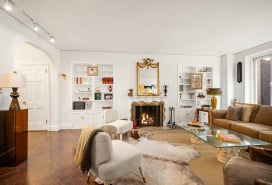What is a 'classic six' apartment and why is it so desirable?
- The six rooms include a living room, dining room, kitchen, two full bedrooms, and a former live-in staff room
- Classic six apartments are prized for prewar features like oak floors, thick walls, solid-core doors, and large rooms
- Most are on the Upper East and Upper West sides of Manhattan; prices range from $1 million to over $3 million

A separate dining room is a traditional feature of classic six apartments, including this two-bedroom, two-bath co-op at 955 Lexington Ave. in Lenox Hill that's asking $1 million.
If you’re drawn to New York’s older prewar buildings, you’re probably a fan of the classic six. These apartments boast high ceilings and decorative details like plaster moldings—and, as the name suggests, a layout with six separate rooms.
A classic six also typically has other coveted features, including large rooms, wood floors, solid-core doors, and fireplaces. These types of apartments can allow for some flexibility to accommodate a home office or expand a smaller kitchen, which can be hard to find in many new developments or refurbished buildings.
Classic six apartments are mostly found on Manhattan’s Upper East and Upper West sides, with a smattering in Brooklyn.
In this Buy Curious column, Marcy Sigler, a broker at Compass, explains the benefits and drawbacks of this type of apartment.
[Editor's note: An earlier version of this post was published in September 2023. We are presenting it with updated information for October 2024.]
The question:
I’ve been looking at apartment listings, and I keep running into the phrase “classic six” (and "classic five," "classic seven," and so on). What exactly does that mean, and why is it desirable? Will I pay more to live in one? Where are they located?
The reality:
“This term refers to a prewar apartment with six rooms, generally including the kitchen and bedrooms, and excluding the bathrooms, pantries, and entrance galleries,” Sigler says.
A classic six has a living room, a formal dining room with a window, a separate kitchen (usually with a window), two full bedrooms, and what was previously a live-in staff room—traditionally located off the kitchen with its own full bathroom or half-bath.

A classic five lacks the staff room, while a classic seven has an extra bedroom, and the rare classic eight has an additional small room.
If you're not seeing enough apartments for sale in your price range or target neighborhood—and/or you'd like to avoid a bidding war—consider expanding your search to "off-market" listings. NYC real estate brokerage The Agency, a Brick Underground partner, uses technology to mine public records and identify owners who may be ready to sell, meaning you can meet and deal with owners before their homes hit the market. Click here to learn more.
What are classic sixes like?
These apartments are known for quintessential prewar features, such as oak floors, thick walls, solid-core doors, generous room proportions, a dining room, and the ultimate status symbol—a working wood-burning fireplace (though in updated iterations, the fireplace might be decorative).
Where can you find a classic six?
“You'll often find classic apartments in co-op buildings that date back to the 1920s through 1940, primarily on the Upper East Side and Upper West Side,” Sigler says.
That said, developers of new construction are incorporating some of the classic six details into their current projects.
“In recent years, developers of condo buildings like 520 Park Ave. in Lenox Hill and 220 Central Park South in Midtown have co-opted the classic layout, combining those old-school embellishments with modern extras like garages, gyms, pools, and screening rooms,” Sigler says.
The same can be said for developments in Brooklyn, notably Front & York in DUMBO and 11 Hoyt in Downtown Brooklyn.
“So if you're enamored with the prewar style, you don’t have to confine your search to decades-old buildings—or pass a co-op board,” she says.
How many classic sixes are for sale at the moment?
Fewer than 35 apartments listed on StreetEasy are described as a classic six, primarily in Uptown Manhattan. Of these, 23 are in prewar co-ops. Some have already been reconfigured from their original design.
Prices for classic six apartments on the market range from $720,000 to over $3 million.
Why would someone want to buy a classic six?
The pros of purchasing a classic six include high ceilings of at least nine feet as well as prewar details like plaster moldings and cornices.
Some people also like the fact that classic sixes have defined living areas. The apartment is typically divided into three zones—public (living room, dining room, library), private (bedrooms), and so-called staff quarters (including the kitchen).
There are usually hallways separating these areas, which also help define the spaces
What are the disadvantages of buying a classic six?
A classic six can make you feel somewhat boxed in and many New Yorkers prefer open plans with fewer walls and living spaces that feel more expansive.
“The lack of an open layout could be a downside if you have small children you want to keep an eye on,” Sigler says. However, class six apartments are often renovated to create a great room with a combined living and dining area.
Finally, while a so-called staff room might have had a useful function when the apartment was built, these days it is likely marketed as a home office space or a guest bedroom.
Want to see if classic six-style living appeals to you? Check out these apartments currently on the market.

136 East 64th Street #6B, Lenox Hill
This newly renovated, 1,800-square-foot corner unit has nine-foot ceilings, newly refinished hardwood floors, a semi-private elevator landing, grand foyer, formal dining room, living room with decorative fireplace and built-in shelving, windowed chef's kitchen with a breakfast bar, and HVAC units. All three bedrooms have en suite baths, including the smaller one. The apartment is being sold with furniture (optional) and a credit for the cost of window replacements; storage is included. The $2.9 million listing in a full-service 1928 building with 65 units on 11 stories. Maintenance is $4,443 per month.

110 Riverside Drive, #15C, Upper West Side
On the market for $2.6 million and with $3,377 in monthly maintenance, this 1,900-square-foot, classic six co-op includes a semi-private elevator landing, open living/dining area, den/media room, and windowed chef's kitchen with marble countertops and high-end appliances, including a wine refrigerator and dishwasher. The primary ensuite bedroom features a windowed dressing area and two custom closets. The 1928 building has 55 units and a 24/7 attended lobby, live-in super, fitness center, children’s playroom, bike room, laundry, and storage.

255 West 108th St., #4E, Manhattan Valley
This light-filled classic six includes a grand foyer, living room with a decorative fireplace, and dining room with original quarter-sawn oak paneling, beamed ceilings, and two exposures. There are two full bedrooms, one full bath, and a smaller bedroom off the kitchen with its own half bath. Other features include prewar details, an in-unit washer/dryer, and dishwasher. It is listed for $1.325 million; monthly maintenance is $2,992. Built in 1910, the 12-story Manchester has 102 units, a full-time doorman, live-in super, children’s room, laundry room, and bike storage.

139 East 94th St., #9A, Carnegie Hill
Recently renovated with prewar details and luxury finishes, this classic six is on the market for $1.995 million, reduced from $2.150 million. It comprises a spacious living room with a wood-burning fireplace custom shelving and East River views; formal dining room; eat-in kitchen with stainless steel appliances and butler's pantry; a laundry room; and central air. There are two full bedrooms, each with ensuite baths; the primary suite has a walk-in closet. The former staff room has its own bath. Monthly maintenance is $4,555. The 11-story, 45-unit building, dating to 1928, has a full-time doorman, live-in super, bike storage, and available storage.

3215 Avenue H, #6C, Flatbush
This recently renovated classic six, listed for $720,000 and with $1,134 monthly maintenance, is currently configured as a two bedroom, two bath with a windowed flex space that could be used as a legal bedroom. The chef's kitchen has custom cabinetry, quartz countertops, and high-end appliances, including a dishwasher and under-counter beverage cooler. Additional features include Pergo laminate flooring, two through-wall AC units and a private balcony. It is located in The Norma, a 1961, 11-story building with 190 units, 24/7 door attendants, a live-in super, bike storage, laundry facilities, parking garage (with a waitlist), and outdoor swimming pool.
Previous versions of this article included reporting and writing by Leah Hochbaum Rosner.
You Might Also Like































